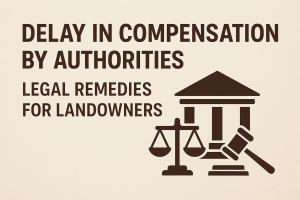Land disputes form one of the largest segments of civil litigation in India, often dragging on for years due to unclear ownership, overlapping jurisdiction, and outdated land records. According to NITI Aayog, nearly two-thirds of all pending civil cases in India are related to land and property.
As the country embraces technology-driven governance, Artificial Intelligence (AI)—particularly Predictive Analytics—is emerging as a powerful tool to detect, prevent, and even resolve land disputes before they escalate into prolonged litigation.
1. Understanding Predictive Analytics in Law
Predictive analytics involves using data, algorithms, and statistical models to identify patterns and forecast potential outcomes. In the legal context, this means analyzing historical litigation data, judgments, and transaction records to predict the likelihood of future disputes or detect risk factors in real-time.
When applied to land and revenue law, predictive analytics can identify red flags such as:
- Multiple ownership claims on the same property
- Delays or gaps in mutation
- High-risk transactions involving benami entities
- Areas prone to encroachment or illegal conversion
This allows authorities, buyers, and even courts to anticipate disputes before they arise.
2. How AI and Predictive Analytics Work in Land Governance
(a) Data Integration from Multiple Sources
AI can analyze data from land registries, cadastral maps, court records, and satellite imagery.
By integrating these datasets, the system can identify inconsistencies or ownership overlaps that typically go unnoticed.
(b) Pattern Recognition for Dispute Prediction
Machine learning algorithms can detect recurring patterns—such as repeated transfers between the same parties, undervalued sales, or frequent mutation rejections—that signal potential conflict zones or fraudulent activity.
(c) Litigation Probability Scoring
Based on historical data, AI models can assign a “litigation risk score” to a particular parcel of land or transaction.
This can assist banks, investors, and even state authorities in decision-making—helping them avoid high-risk land dealings.
(d) AI-Powered GIS Mapping
Geospatial AI models, when layered over digital land maps, can visually highlight encroachment zones, disputed boundaries, or land under multiple claims—empowering both administrators and litigants with clear insights.
3. Benefits of Predictive Analytics in Reducing Land Litigation
- Early Detection of Disputes: Authorities can intervene before conflicts reach the court.
- Transparent Decision-Making: Automated analysis minimizes human bias and manipulation.
- Efficient Revenue Administration: AI reduces time spent on verification and mutation, improving public trust in revenue offices.
- Faster Real Estate Transactions: Buyers can check litigation-risk scores before purchase, ensuring legal clarity.
- Support for Judicial Reforms: Courts can prioritize genuinely complex cases while administrative ones get resolved pre-litigation.
- Challenges and Legal Concerns: Despite its potential, predictive analytics in land governance comes with critical challenges:
- Data Quality: Inconsistent or incomplete land records may produce inaccurate predictions.
- Privacy & Ethics: Ownership and financial data must be safeguarded under the Digital Personal Data Protection Act, 2023.
- Legal Accountability: Decisions based on AI predictions must always involve human oversight to uphold natural justice.
- Integration Issues: Coordination between land, revenue, and judicial databases remains a major obstacle.
A well-designed regulatory framework is therefore essential to ensure responsible use of predictive analytics in legal decision-making.
5. Case Studies and Emerging Initiatives
Several Indian states are already experimenting with data-driven governance:
- Madhya Pradesh and Karnataka have introduced AI-assisted mapping and record reconciliation systems.
- Telangana’s Dharani Portal integrates registration and mutation workflows digitally—paving the way for AI-led analysis in the future.
Globally, countries like Estonia and Singapore are leveraging predictive analytics to forecast administrative disputes and automate title verifications—models India can adapt to its vast and diverse land ecosystem.
6. The Road Ahead
For India, the future lies in combining LegalTech innovation with revenue administration reform.
By embedding predictive analytics into land registration and e-governance systems, the government can drastically reduce litigation and improve public confidence.
Law firms, too, can leverage these insights to offer risk advisory services—helping clients avoid disputes through informed legal due diligence.
Conclusion
Predictive analytics marks the next leap in India’s journey toward intelligent land governance.
By identifying risks before they turn into courtroom battles, AI empowers citizens, administrators, and the judiciary alike.
If implemented ethically and transparently, it could transform the dream of “Ease of Doing Land Business” into a tangible reality—delivering justice not only faster, but smarter.



